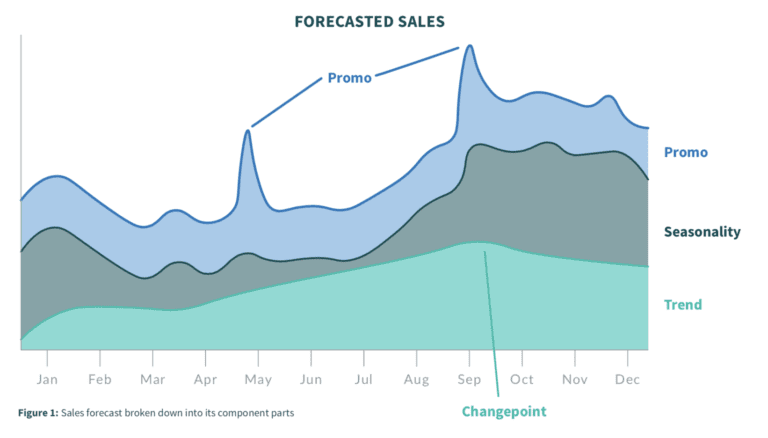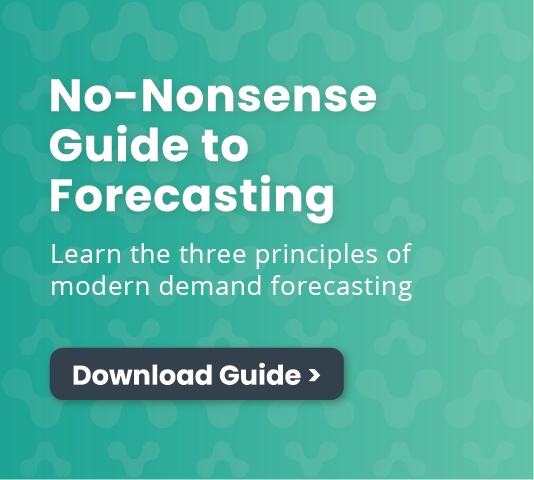- Franklin Morris
Forecasting is the process of estimating future demand in order to help make better-informed business decisions today. Across consumer goods brands, teams use forecasts to more intelligently allocate resources, optimize inventory management, and maximize revenue.
However, companies vary widely in their forecast accuracy. According to the Institute of Business Forecasting & Planning (IBF), the retail industry averages a 30% error rate when forecasting products one month in advance, and “Best-in-Class Forecast Errors” is even a term in the IBF glossary.
They define it as “The average forecasting errors of ‘best-in-class’ companies, which may be the average of the top 25 or 30 performing companies.” That’s accurate (no pun intended), but it doesn’t provide any actual clues as to how to achieve a best-in-class forecast error. In this post, we’ll build on the principles of modern demand forecasting that we’ve outlined and share some key steps for a best-in-class forecasting process. These best practices will help you build a more accurate forecast to support short-term (S&OE) and long-term (S&OP) planning.
Assemble the Necessary Inputs
Compared to predicting the future, data preparation might seem like the easy part of the process. But if you thought it’s actually harder than it sounds, you’re right.
You don’t use sell-in data or even actual sell-out to build a best-in-class forecast, but rather unconstrained demand: how much product you would sell if you never ran out of stock in any channel. To properly calculate this number that we call “true demand,” you must look at both sell-through and out-of-stocks.
Additional important inputs for a value-add forecast are channel inventory and shipment units; these data points give you a full picture of where your product currently is. Lastly, keep in mind your target goal for channel weeks of supply, taking into consideration working capital needs, storage costs, out-of-stock costs, shelf life and other factors.
An accurate and actionable forecast also requires the most up-to-date data available. If you’re trying to forecast next month’s demand using data from two months ago, your error rate is going to be higher than if you had data up to yesterday, reflecting the latest consumer trends.
Create a Baseline
As you assess true unconstrained demand, understand the outliers in your data and account for them to create a baseline forecast. For example, a certain spike in sales may be the result of an influencer advertising your product. This event probably won’t happen again with regularity, so you don’t want to let it influence your baseline. The goal of a baseline forecast is essentially to serve as your “normal” forecast, not counting promotions or other special events.
The key part of your baseline is seasonality一the regular fluctuations in demand that occur quarterly, monthly, weekly, or even daily. You can determine seasonality patterns by bringing in multiple years of sales data to identify trends, and of course, the more historical data you have at your disposal, the easier it will be. With new products, you will need to look to alternative data, like similar products, to extract seasonality.

Adjust the Forecast
For demand planning, you’ll need to adjust the baseline forecast to reflect internal and external changes that impact the business. The last part of best-in-class forecasting is thus sizing the impact of these events, so you can use data to adjust the forecast accordingly.
Changepoints and events to think through include:
- Where is the product in its lifecycle? Has it just been introduced, or are you sunsetting it?
- Will any strategic business decisions have an impact on the product sales?
- Will larger industry trends spill over into the performance of a product?
- Are there any promotions or brand marketing activities planned for the product?
By adding these factors on top of your baseline, you’ll achieve a more realistic view of predicted demand. Each company and industry is unique, and this step really allows you to tailor your model to your specific needs.
At Alloy, we’re committed to making demand forecasting easier by automating much of the data preparation work and facilitating continual forecast updates based on the latest sales and inventory information. If you’re interested in a more in-depth look at best-in-class forecasting, check out The No-Nonsense Guide to Forecasting!

Franklin Morris
Franklin Morris is Vice President and Head of Global Marketing at Alloy.ai. He's spent his career leading brand, content and demand generation marketing for high-growth startups, ad agencies, and Fortune 50 giants, including IBM, Dell, Oracle, Rackspace, 3M, Facebook, Electronic Arts, Informatica, Sisense, and Argo Group.

Alloy.ai Drives 35% YoY Forecast Accuracy Improvement at Ember
Alloy.ai’s software also helps Ember drive inventory efficiency, scale its access to retail point-of-sale data, and align internal functions around a single source of truth…

The consumer brands’ ultimate guide to improving forecast accuracy
With demand uncertainty and supply constraints, forecasting is more important than ever for consumer brands. Our guide shares ways brands can improve their forecast accuracy,…

Planning and forecasting best practices from a leading personal-care brand
Larra Haftevani from Billie talks how she thinks about planning for a retail launch, and the value of retailer-provided forecasts and doing your own forecasting…



